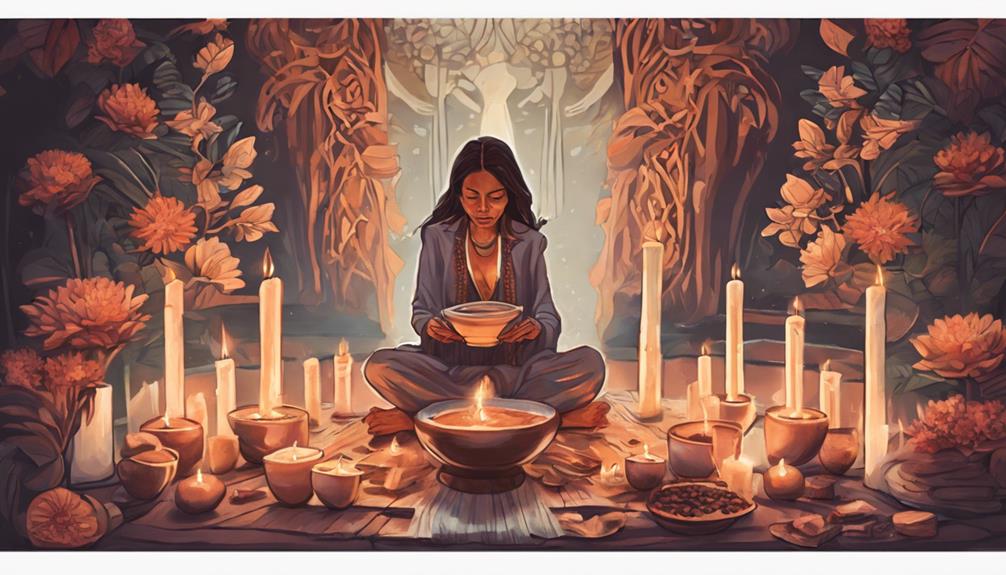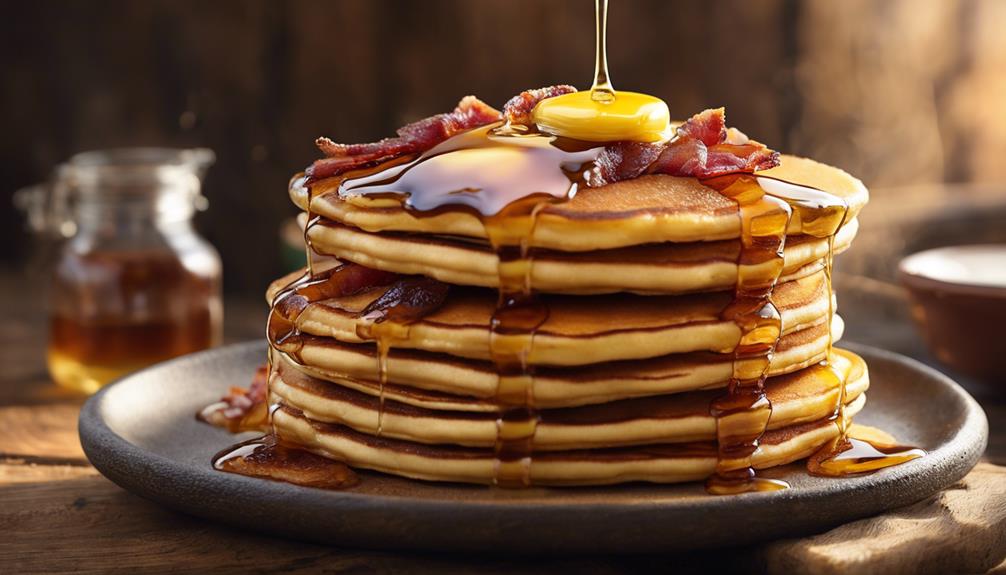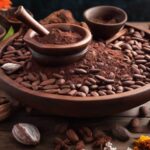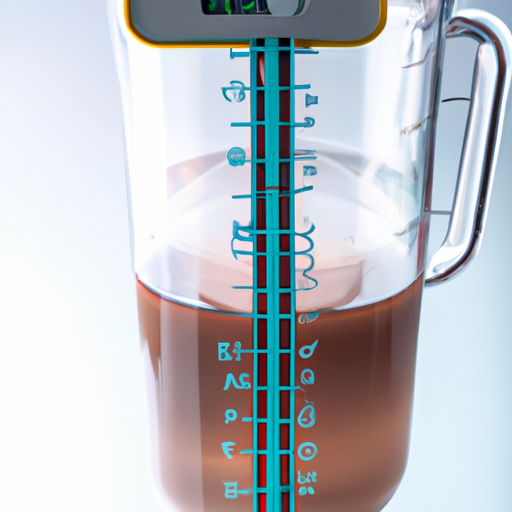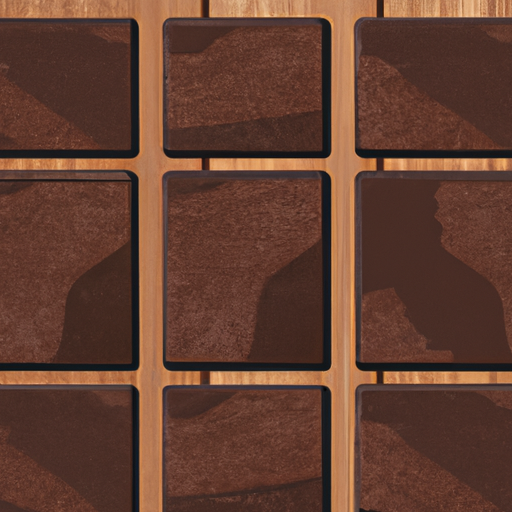Crafting a sacred cacao ceremony requires seven key steps. Initially, choose pure ceremonial cacao such as Criollo or Trinitario for a transformative encounter. Next, create a sacred environment by cleansing energies and setting up comforting elements like blankets and crystals. Then, carefully prepare your cacao elixir by recognizing its advantages and infusing it with love and appreciation. Lastly, enrich the taste by incorporating spices like cinnamon and turmeric for a sensory journey.
Next, savor the ceremonial drink for its heart-warming effects and mood enhancement. Finally, after the ceremony, reflect on the experience, stay hydrated, and journal for self-awareness. Each step contributes to a meaningful and transformative cacao ceremony.
Key Takeaways
- Select high-quality Criollo or Trinitario cacao for a transformative experience.
- Set up a sacred space with intention, blankets, pillows, incense, and soothing music.
- Mindfully craft a cacao elixir with chosen spices, love, and gratitude.
- Enhance flavor profiles with cinnamon, maca, chili powder, and more.
- Reflect, hydrate, and journal post-ceremony for emotional processing and growth.
Selecting Pure Ceremonial Cacao
When selecting ceremonial cacao for a sacred ritual, choose pure varieties like Criollo or Trinitario to guarantee a powerful and transformative experience.
Pure ceremonial cacao, sourced from these specific cacao varieties, holds the energetic properties needed for heart-opening and profound moments during the ceremony.
The quality of the cacao you choose sets the stage for the depth of your experience.
Ceremonial cacao, unlike regular cacao, undergoes special processing methods that preserve its energetic qualities, making it ideal for spiritual practices.
By selecting high-quality ceremonial cacao, you secure a potent and effective journey into the heart space.
The intention behind choosing pure ceremonial cacao is to create a meaningful and powerful cacao ceremony experience that resonates deeply within you.
Setting Up Sacred Space

Creating a tranquil environment with blankets, pillows, incense, crystals, and soothing music sets the stage for a sacred cacao ceremony. Here are three essential steps to set up a sacred space for your ceremony:
- Clear the Energy:
Before starting your cacao ceremony, use sage or palo santo for smudging to cleanse the space of any negative energy. This helps purify the environment and sets a sacred tone for the upcoming ritual.
- Set Intentions:
Take a moment to reflect on your intentions for the ceremony. Whether it's for healing, self-discovery, or gratitude, setting clear intentions can guide the energy of the ceremony and enhance your overall experience with the cacao.
- Create a Sacred Atmosphere:
Arrange your space with care, ensuring that it's comfortable and inviting. Add personal touches like meaningful objects, candles, or sacred symbols to create a space that feels special and conducive to introspection and connection with the cacao spirit.
Crafting Cacao Elixir Mindfully
Crafting a cacao elixir mindfully involves understanding the benefits of this ceremonial drink, preparing it with intention, and enhancing its flavors with chosen spices. By focusing on the process of making the elixir, setting intentions, and selecting ingredients thoughtfully, one can create a personalized and sacred experience.
Adding herbs like cinnamon, maca, chili powder, or vanilla not only enriches the taste but also deepens the mindful connection to the cacao elixir.
Cacao Elixir Benefits
Crafting a cacao elixir mindfully enhances the ceremonial experience by infusing intention into each carefully selected ingredient. When preparing a cacao elixir, the benefits go beyond taste, offering heart-warming effects, mood enhancement, and a deeper connection to the ritual.
To fully appreciate these advantages, it's essential to understand the significance of high-quality ingredients in your elixir. Here are three key benefits of a well-crafted cacao elixir:
- Heart-Warming Effects: The warmth of the cacao elixir can create a comforting sensation that spreads through your body, fostering a sense of inner peace and contentment.
- Mood Enhancement: The natural compounds in cacao can uplift your mood and promote feelings of joy and relaxation.
- Connection to the Ritual: Each sip of the cacao elixir can deepen your connection to the ceremonial experience, allowing you to be fully present and engaged.
Mindful Preparation Techniques
In my mindful preparation of the cacao elixir, I prioritize selecting high-quality ceremonial cacao to enhance the sacred experience. Choosing the right cacao is like laying a vital foundation for the ceremony, ensuring a rich and authentic flavor profile.
Creating a sacred space is essential; it helps set the tone for the ritual and allows you to fully immerse yourself in the experience. Setting clear intentions for your cacao ceremony is a pivotal practice that can deepen your connection to the elixir's energy.
Infusing the cacao elixir with love and gratitude not only adds positive vibes but also enhances the overall experience. Paying attention to details like blending techniques and ingredients is vital, as it can make a significant difference in the final taste and texture.
Mindful stirring and focusing on the process of making the cacao elixir can bring a sense of mindfulness and presence to the ceremony, enriching the entire experience.
Enhancing Flavor Profiles
Enhancing the flavor profiles of a cacao elixir involves skillfully blending spices like cinnamon, maca, chili powder, vanilla, turmeric, and black pepper.
- Start by selecting high-quality spices to guarantee a rich and aromatic cacao drink.
- Experiment with different spice combinations to discover unique flavor profiles that resonate with your palate.
- Remember to start with small amounts of spices and adjust gradually to achieve the perfect balance in your cacao elixir.
Crafting a cacao elixir mindfully with the right spices can transform a simple drink into a sensorial experience that delights the taste buds and uplifts the spirit. Experiment, taste, and feel the magic of enhancing the flavor profiles of your ceremonial cacao elixir.
Infusing With Intention
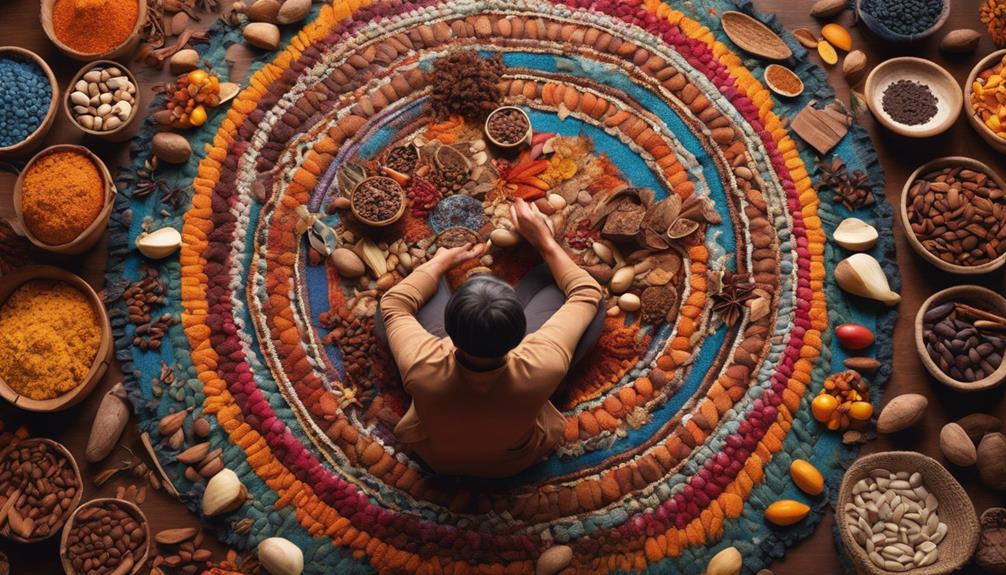
Intentionally infusing cacao with purpose before the ceremony elevates the spiritual connection and energy flow. Setting intentions with ceremonial grade cacao is a powerful practice that deepens the bond between oneself and the plant medicine. By infusing the cacao with specific intentions, you can enhance the effects of the ritual and bring about a more profound experience. This intentional preparation creates a sacred space where you can align your goals and desires with the healing properties of the cacao.
To guide you in infusing your cacao with intention, consider the following table:
| Intention | Effect | Example |
|---|---|---|
| Love | Amplifies heart opening and connection with others | Setting the intention to open your heart to love and compassion during the ceremony |
| Healing | Enhances physical and emotional healing | Infusing the cacao with the intention to heal past wounds and promote inner balance |
| Clarity | Improves focus and mental clarity | Setting the intention to clear your mind and gain insight during the ceremony |
Infusing your ceremonial grade cacao with intention is a beautiful way to deepen your connection with the plant medicine and set the stage for a transformative experience.
Savoring the Ceremonial Drink
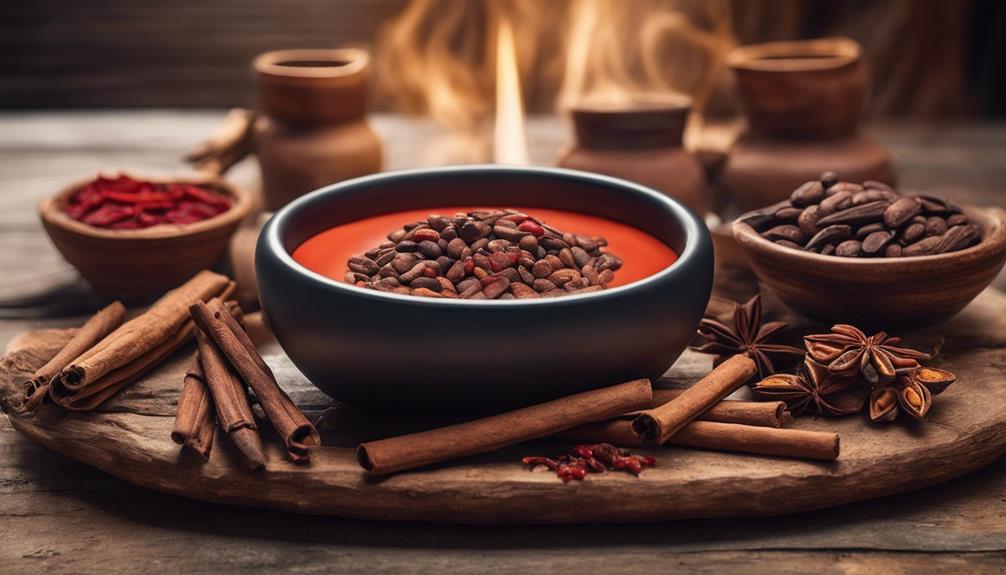
When savoring the ceremonial drink, exploring its flavor profiles adds richness to the experience.
Mindful consumption allows for a deeper connection with the cacao's essence, enhancing its effects.
Taking slow, deliberate sips can amplify the ceremony's impact on the heart space, creating a profound and reflective moment.
Flavor Profiles
For a truly personalized cacao ceremony experience, exploring diverse flavor profiles by incorporating spices, herbs, and sweeteners can elevate the enjoyment of the ceremonial drink.
- Cacao Paste: Using high-quality cacao paste as a base sets the foundation for a rich and authentic cacao flavor.
- Raw Honey: Adding a touch of raw honey not only sweetens the drink but also enhances its natural earthy tones.
- Natural Sweetener: Opting for natural sweeteners like coconut sugar can bring a subtle sweetness that complements the bitterness of the cacao, creating a well-balanced flavor profile.
Experimenting with these elements can help you create a unique blend that resonates with your taste buds, making your cacao ceremony a truly sensory delight.
Mindful Consumption
Savoring the ceremonial cacao drink slowly allows for a full experience of its effects and flavors. Prepare your Ceremonial Cacao by taking a moment to close your eyes.
As you bring the cup to your lips, take your time with each sip. Let the warm liquid dance on your taste buds, noticing its rich and deep flavors. Allow the cacao to interact with your senses, engaging with the aroma, taste, and texture.
With each mindful sip, observe how it affects your body, mind, and spirit during the ceremony. Embrace the heart-opening properties of the cacao as you consume it with intention and gratitude. Remember, the key is to be present and fully immerse yourself in this sacred experience.
Reflecting and Sharing
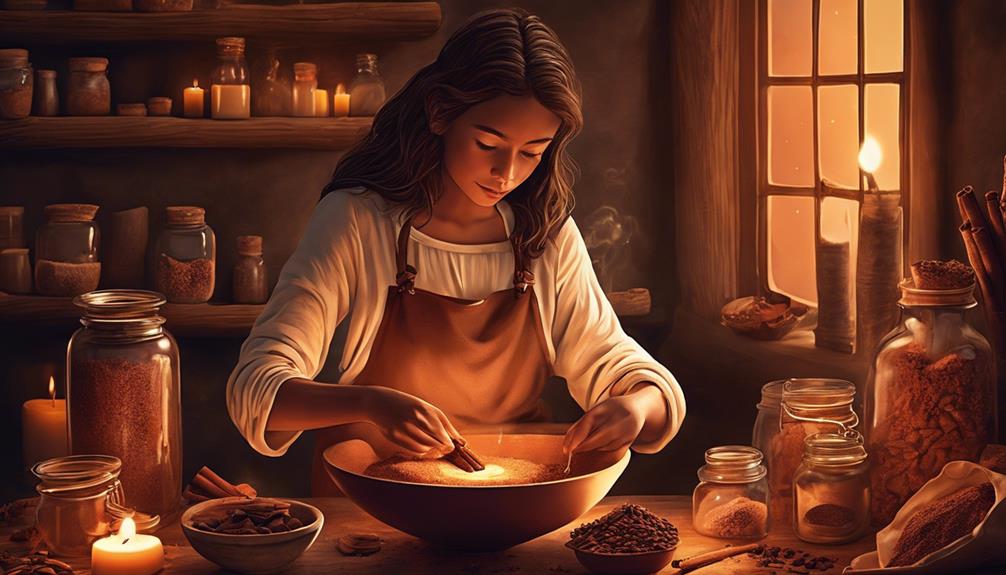
Engaging in reflection and sharing post-cacao ceremony is essential for integrating the experience and deepening connections within the cacao community.
- Reflecting: Taking time to sit quietly and reflect on the insights gained during the ceremony can help in processing emotions and lessons learned. Journaling about these reflections can provide a tangible record of your growth journey.
- Sharing: Discussing your thoughts and experiences with others who've participated in the ceremony fosters a sense of community and understanding. Sharing openly can create deeper connections and offer different perspectives on the shared experience.
- Journaling: Writing about your cacao ceremony experience in a journal allows for deeper self-awareness, personal growth, and integration of the cacao's effects. It can be a powerful tool for tracking your progress, identifying patterns, and exploring the impact of the ceremony on your daily life.
Hydration for Integration
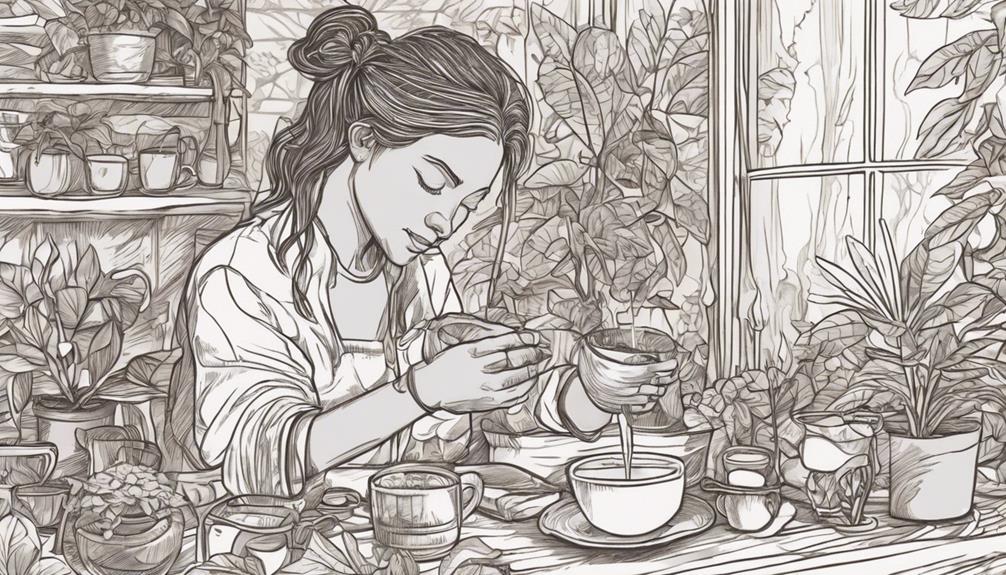
After pondering on the insights gained during the cacao ceremony, maintaining proper hydration becomes essential for integrating the effects of ceremonial cacao. Hydration plays a vital role in supporting the body as it processes and absorbs the nutrients from the cacao.
Drinking water at this time is fundamental for maintaining balance and preventing dehydration post-ceremony. It can also enhance your overall experience and well-being after the ceremony. By making hydration a priority, you're actively contributing to a smoother shift back to your daily activities.
To integrate this practice effectively into your post-ceremony routine, make sure to have a water bottle handy and sip on water regularly. Additionally, herbal teas or coconut water can be invigorating alternatives to plain water.
Frequently Asked Questions
How to Do a Cacao Ceremony Step by Step?
To do a cacao ceremony step by step, I create a sacred space, prepare ceremonial cacao with intention, set up the ambiance, taste mindfully, and embrace post-ceremony reflection. Each sip nourishes my soul.
What Are the Active Ingredients in Cacao Ceremonies?
Oh, you're curious about the active ingredients in cacao ceremonies? Let me tell you, cacao is packed with theobromine, phenylethylamine, and anandamide – the dream team for mood-boosting and heart-opening magic!
How Is Ceremonial Cacao Made?
Ceremonial cacao is crafted with high-quality beans like Criollo or Trinitario. Harvested, fermented, dried, roasted, and ground into paste or powder. Hand-processed traditionally, with added special ingredients for flavor and intention. The process honors the cacao plant's spirit.
How Many Tablespoons of Cacao for Ceremony?
I typically measure my cacao for ritual in grams, aiming for the best dose of around 25-42g per person. It's a personal choice based on desired effects. I find this method guarantees a meaningful experience for myself and others.
Can Sciroppi Recipes Be Incorporated Into a Sacred Cacao Ceremony?
Yes, delicious sciroppi recipes can add an extra element to a sacred cacao ceremony. The sweet and flavorful syrup can be incorporated into ceremonial drinks or used as a topping for cacao-infused desserts, enhancing the overall experience with its unique taste and aroma.
Conclusion
To sum up, crafting a sacred cacao ceremony is a deeply transformative experience that can elevate your spiritual practice. By following these 7 steps with pure ceremonial cacao, intention, and mindfulness, you can create a powerful elixir that nourishes both body and soul.
Remember to savor each sip, reflect on the experience, and hydrate for integration. This ceremony will surely ignite your senses and create a sacred space unlike any other.

